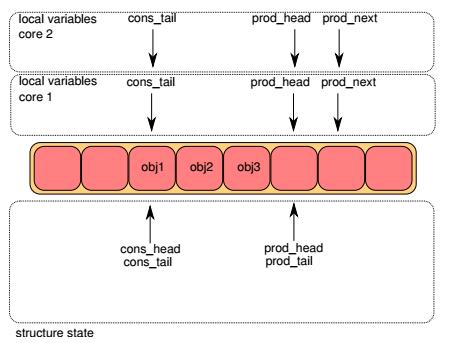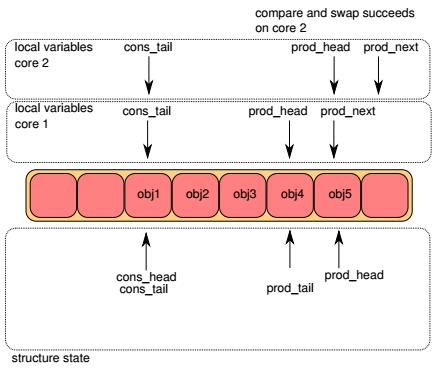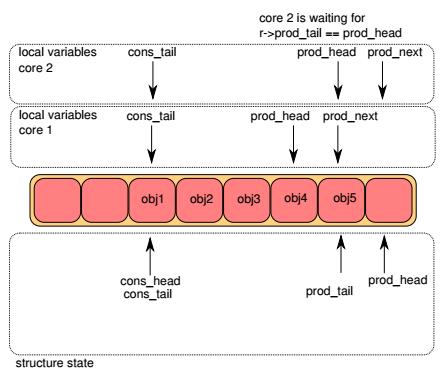dpdk无锁队列rte_ring实现分析 Posted 2023-02-13 rayylee
tags:
篇首语:本文由小常识网(cha138.com)小编为大家整理,主要介绍了dpdk无锁队列rte_ring实现分析相关的知识,希望对你有一定的参考价值。
1. 概述 rte_ring(以下简称ring)是一个高效率的无锁环形队列,它具有以下特点:
FIFO 队列长度是固定的,所有指针存放在数组中 无锁实现(lockless) 多消费者或单消费者出队 多生产者或单消费者入队 批量(bulk)出队 - 出队N个对象,否则失败 批量(bulk)入队 - 入队N个对象,否则失败 突发(burst)出队 - 尽可能地出队N个对象 突发(burst)入队 - 尽可能地入队N个对象 与链表实现的队列相比,ring有以下优点:
更快 - 仅需要一次CAS(Compare-And-Swap)操作 比完全无锁的队列实现更简单 适配批量操作 - 由于指针存放在数组中,相比链表式队列多个对象的操作没有太大的cache miss 当然,ring也有缺点:
队列长度固定 比链表式队列更消耗内存(因为创建的时候队列长度便固定了) ring的实现借鉴了 [freebsd_ring] 和 [linux_ringbuffer] 。每个ring都有唯一的名字。 用户不可能创建两个具有相同名称的ring(如果尝试调用rte_ring_create()这样做的话,将返回NULL)。
2. ret_ring 无锁队列操作图解 下面将以多生产者(multi-producer, mp)的情形来说明ring入队时的操作,多消费者出队的基本原理可以此类比。
每个ring都有两对head,tail指针,一对用于生产者(入队),另一对用于消费者(出队)。在下面各图中,上半部分表示lcore入队函数的局部变量, 下半部分表示ring的成员变量。objX表示队列中的对象。
Step1
一开始,lcore1和lcore2局部变量pro_head和cons_tail都和queue成员一致,局部变量prod_next都指向队列插入位置,即prod_head的前面。
Step2
接下来两个lcore通过CAS指令进行竞争,更新ring->prod_head改为胜者lcore的prod_next:
如果ring->prod_head != prod_head, CAS失败,返回Step1 否则,CAS成功,ring->prod_head = prod_next 下图中,lcore1竞争获胜,而lcore2需要重新进行Step1:
Step3
lcore2上的CAS操作也成功。lcore1将obj4入队,lcore2将obj5入队。
Step4
两个lcore进行竞争,更新ring->prod_tail:
如果ring->prod_tail != prod_head,CAS失败,继续尝试 否则,CAS成功, ring->prod_tail = prod_next 下图中,lcore1竞争获胜,lcore1上的入队操作到此结束。
Step5
lcore2如Step4一样,更新ring->prod_tail。至此lcore2的入队操作也已完成。
3. 代码分析 3.1 rte_ring 结构体:
1 struct rte_ring char name[RTE_RING_NAMESIZE]; /**< Name of the ring. */ 3 int flags; /**< Flags supplied at creation. */ 4 const struct rte_memzone * memzone; /**< Memzone, if any, containing the rte_ring */ 6 struct prod uint32_t watermark; /**< Maximum items before EDQUOT. */ 9 uint32_t sp_enqueue; /**< True, if single producer. */ 10 uint32_t size; /**< Size of ring. */ 11 uint32_t mask; /**< Mask (size-1) of ring. */ 12 volatile uint32_t head; /**< Producer head. */ 13 volatile uint32_t tail; /**< Producer tail. */ 14 prod __rte_cache_aligned; struct cons uint32_t sc_dequeue; /**< True, if single consumer. */ 18 uint32_t size; /**< Size of the ring. */ 19 uint32_t mask; /**< Mask (size-1) of ring. */ 20 volatile uint32_t head; /**< Consumer head. */ 21 volatile uint32_t tail; /**< Consumer tail. */ 22 #ifdef RTE_RING_SPLIT_PROD_CONS 23 cons __rte_cache_aligned; #else 25 cons; #endif 27 #ifdef RTE_LIBRTE_RING_DEBUG 29 struct rte_ring_debug_stats stats[RTE_MAX_LCORE]; #endif 31 void * ring[ 0 ] __rte_cache_aligned; /**< Memory space of ring starts here. 33 * not volatile so need to be careful 34 * about compiler re-ordering */ 35 ;
3.2 入队函数 __rte_ring_mp_do_enqueue :
1 static inline int __attribute__ ((always_inline)) struct rte_ring * r, void * const * obj_table, unsigned n, enum rte_ring_queue_behavior behavior) uint32_t prod_head, prod_next; uint32_t cons_tail, free_entries; const unsigned max = n; int success; unsigned i, rep = 0 ; uint32_t mask = r -> prod.mask; int ret; do = max; = r -> prod.head; = r -> cons.tail; = (mask + cons_tail - prod_head); if (unlikely(n > free_entries)) if (behavior == RTE_RING_QUEUE_FIXED) return - ENOBUFS; else if (unlikely(free_entries == 0 )) return 0 ; = free_entries; = prod_head + n; 34 success = rte_atomic32_cmpset( & r -> prod.head, prod_head, while (unlikely(success == 0 )); 37 39 rte_smp_wmb(); 40 if (unlikely(((mask + 1 ) - free_entries + n) > r -> prod.watermark)) = (behavior == RTE_RING_QUEUE_FIXED) ? - EDQUOT : 43 ( int )(n | RTE_RING_QUOT_EXCEED); else = (behavior == RTE_RING_QUEUE_FIXED) ? 0 : n; 49 while (unlikely(r -> prod.tail != prod_head)) 51 if (RTE_RING_PAUSE_REP_COUNT && 53 ++ rep == RTE_RING_PAUSE_REP_COUNT) = 0 ; -> prod.tail = prod_next; return ret;
第34-36行处理多个producer的竞争,没有竞争到写入位置的线程将继续循环。
第39行插入了一个rte_smp_wmb()调用,对这个函数DPDK文档的解释是:
Write memory barrier between lcores. Guarantees that the STORE operations that precede the rte_smp_wmb() call are globally visible across the lcores before the the STORE operations that follows it.
第49行的循环用于无锁同步对prod.tail的修改。
ENQUEUE_PTRS宏函数:
1 #define ENQUEUE_PTRS() do \\ 2 const uint32_t size = r->prod.size; \\ 3 uint32_t idx = prod_head & mask; \\ 4 if (likely(idx + n < size)) \\ 5 for (i = 0; i < (n & ((~(unsigned)0x3))); i+=4, idx+=4) \\ 6 r->ring[idx] = obj_table[i]; \\ 7 r->ring[idx+1] = obj_table[i+1]; \\ 8 r->ring[idx+2] = obj_table[i+2]; \\ 9 r->ring[idx+3] = obj_table[i+3]; \\ 10 \\ 11 switch (n & 0x3) \\ 12 case 3: r->ring[idx++] = obj_table[i++]; \\ 13 case 2: r->ring[idx++] = obj_table[i++]; \\ 14 case 1: r->ring[idx++] = obj_table[i++]; \\ 15 \\ 16 else \\ 17 for (i = 0; idx < size; i++, idx++)\\ 18 r->ring[idx] = obj_table[i]; \\ 19 for (idx = 0; i < n; i++, idx++) \\ 20 r->ring[idx] = obj_table[i]; \\ 21 \\ 22 while(0)
第5行,如果n>4,则把它分成数次写入,每次写入4个指针;不足4的余数在switch语句中写入。
3.3 出队函数 __rte_ring_mc_do_dequeue :
1 static inline int __attribute__ ((always_inline)) struct rte_ring * r, void ** obj_table, unsigned n, enum rte_ring_queue_behavior behavior) uint32_t cons_head, prod_tail; uint32_t cons_next, entries; const unsigned max = n; int success; unsigned i, rep = 0 ; uint32_t mask = r -> prod.mask; do = max; = r -> cons.head; = r -> prod.tail; = (prod_tail - cons_head); if (n > entries) if (behavior == RTE_RING_QUEUE_FIXED) return - ENOENT; else if (unlikely(entries == 0 )) return 0 ; = entries; = cons_head + n; 33 success = rte_atomic32_cmpset( & r -> cons.head, cons_head, while (unlikely(success == 0 )); 36 38 rte_smp_rmb(); 39 40 while (unlikely(r -> cons.tail != cons_head)) 42 if (RTE_RING_PAUSE_REP_COUNT && 44 ++ rep == RTE_RING_PAUSE_REP_COUNT) = 0 ; -> cons.tail = cons_next; return behavior == RTE_RING_QUEUE_FIXED ? 0 : n;
1 #define DEQUEUE_PTRS() do \\ 2 uint32_t idx = cons_head & mask; \\ 3 const uint32_t size = r->cons.size; \\ 4 if (likely(idx + n < size)) \\ 5 for (i = 0; i < (n & (~(unsigned)0x3)); i+=4, idx+=4) \\ 6 obj_table[i] = r->ring[idx]; \\ 7 obj_table[i+1] = r->ring[idx+1]; \\ 8 obj_table[i+2] = r->ring[idx+2]; \\ 9 obj_table[i+3] = r->ring[idx+3]; \\ 10 \\ 11 switch (n & 0x3) \\ 12 case 3: obj_table[i++] = r->ring[idx++]; \\ 13 case 2: obj_table[i++] = r->ring[idx++]; \\ 14 case 1: obj_table[i++] = r->ring[idx++]; \\ 15 \\ 16 else \\ 17 for (i = 0; idx < size; i++, idx++) \\ 18 obj_table[i] = r->ring[idx]; \\ 19 for (idx = 0; i < n; i++, idx++) \\ 20 obj_table[i] = r->ring[idx]; \\ 21 \\ 22 while (0)
3.4 32-bit 取模索引
在前面介绍中,prod_head, prod_tail, cons_head 和 cons_tail索引由箭头表示。 但是,在实际实现中,这些值不会假定在0和 size(ring)-1 之间。 索引值在 0 ~ 2^32 -1之间,当我们访问ring本身时,我们屏蔽他们的值。 32bit模数也意味着如果溢出32bit的范围,对索引的操作将自动执行2^32 模。
下面 解释索引值如何在ring中使用。 为了简化说明,使用模 16bit 操作,而不是 32bit 。 另外,四个索引被定义为 16bit 无符号整数,与实际情况下的 32bit 无符号数相反。
这个ring包含11000对象。
这个ring包含12536个对象。
我们在上面的例子中使用模65536操作。 在实际执行情况中,这种低效操作是多余的,当溢出时会自动执行。代码始终保证生产者和消费者之间的距离在0 ~ size(ring)-1之间。 基于这个属性,我们可以对两个索引值做减法,而不用考虑溢出问题 。 任何情况下,ring中的对象和空闲对象都在 0 ~ size(ring)-1之间,即便第一个减法操作已经溢出:
uint32_t entries = (prod_tail - cons_head); uint32_t free_entries = (mask + cons_tail - prod_head);
参考文档 [dpdk_guide_ring] DPDK programmer’s guide - Ring Library
[freebsd_ring] FreeBSD buf_ring
[linux_ringbuffer] Linux Lockless Ring Buffer
[lockfree_queue] Yet another implementation of a lock-free circular array queue
[lockfree_coolshell] 酷壳:无锁队列的实现
以上是关于dpdk无锁队列rte_ring实现分析的主要内容,如果未能解决你的问题,请参考以下文章






